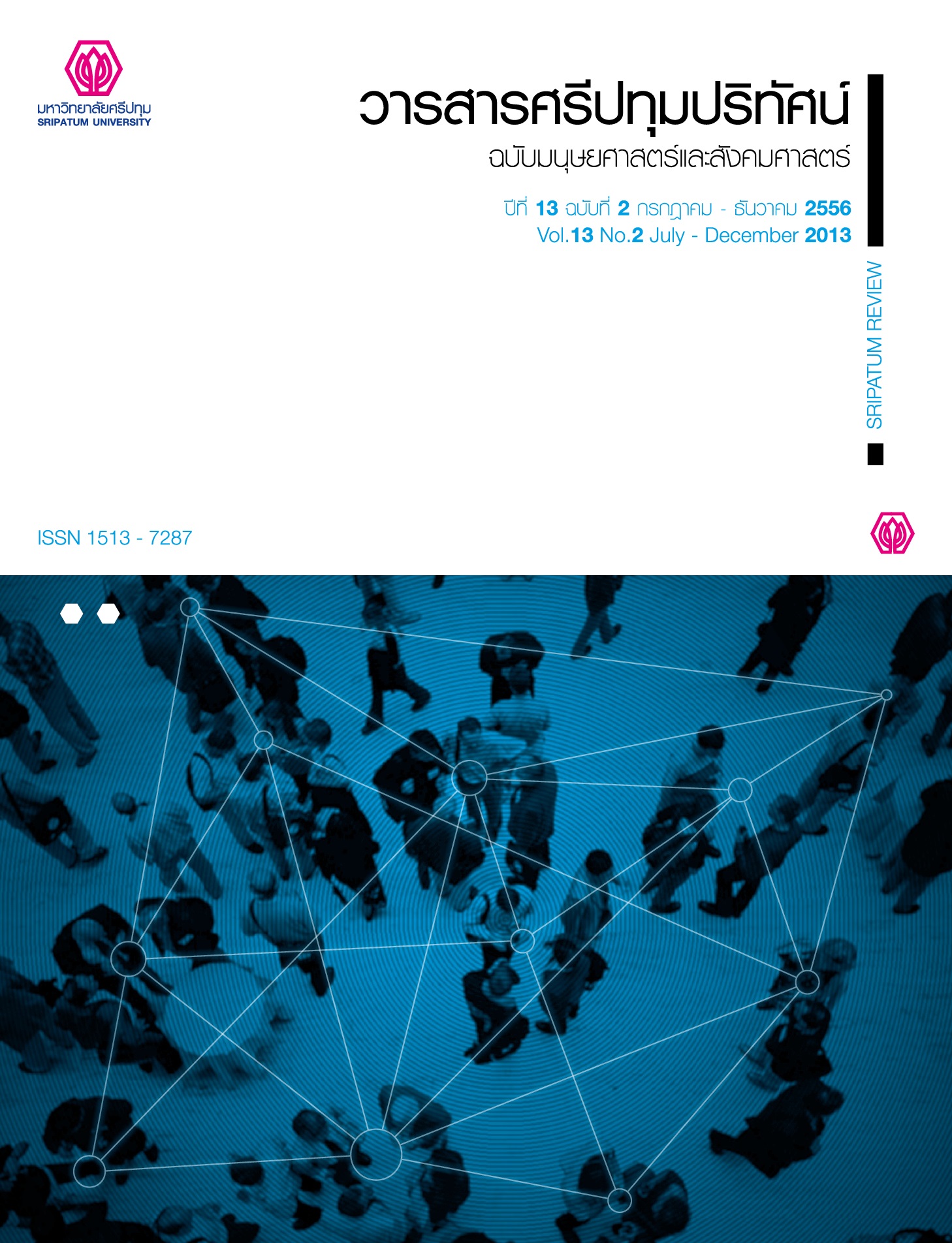FEMALE ADMINISTRATORS’ LEADERSHIP OF THE PUBLIC AND PRIVATE UNIVERSITIES IN BANGKOK
Main Article Content
Abstract
The objectives of this research are 1) to study the leadership level of female administrators of public and private universities in Bangkok metropolitan area; 2) to study the relationships of personal factors, psycho-social factors, and external environment factors with leadership of the female administrators; and 3) to study the factors affecting leadership of the female administrators. This study employed the mixed method research methodology involving quantitative and qualitative research methodologies. The research findings reveal that the overall leadership of female administrators is at the high level. The leadership indicator receiving the highest rating mean is that the administrator must put emphasis on measurement and evaluation that are important to the effectiveness of the organization’s development. The personal factors, psycho-social factors, and external environment factors correlated significantly with leadership at the .05 level. Five following factors are found to affect leadership of female administrators: 1) achievement motive, 2) leadership and empowerment, 3) participation, 4) status and roles of females, and 5) leadership and vision.
Article Details
1. กองบรรณาธิการสงวนสิทธิ์ในการพิจารณาและตัดสินการตีพิมพ์บทความในวารสาร
2. บทความทุกเรื่องจะได้รับการตรวจสอบทางวิชาการโดยผู้ทรงคุณวุฒิ แต่ข้อความและเนื้อหาในบทความที่ตีพิมพ์เป็นความรับผิดชอบของผู้เขียนแต่เพียงผู้เดียว มิใช่ความคิดเห็นและความรับผิดชอบของมหาวิทยาลัยศรีปทุม
3. การคัดลอกอ้างอิงต้องดำเนินการตามการปฏิบัติในหมู่นักวิชาการโดยทั่วไป และสอดคล้องกับกฎหมายที่เกี่ยวข้อง
References
จิรวรรณ ภักดีบุตร. 2541. ผู้หญิงบนเส้นทางนักบริหารในระบบราชการไทย. กรุงเทพฯ: กรมการศึกษานอกโรงเรียน.
ชวลิต เกิดทิพย์. 2553. ภาวะผู้นำทางเทคโนโลยีการศึกษาสำหรับผู้บริหารเพื่อการปฏิรูปการศึกษาทศวรรษที่สอง (พ.ศ.2552 –พ.ศ. 2561). วิทยานิพนธ์ศึกษาศาสตรดุษฎีบัณฑิต สาขาวิชาการบริหารการศึกษา, บัณฑิตวิทยาลัย มหาวิทยาลัยสงขลานครินทร์.
พิรญาณ์ บุญญสถิตย์ และพัชสิรี ชมภูคํา. (2553). ทัศนคติของผู้ใต้บังคับบัญชาต่อผู้บังคับบัญชาที่เป็นสตรี.วารสารจุฬาลงกรณ์ธุรกิจปริทัศน์. 32 (126), หน้า 85-105.
รังสรรค์ ประเสริฐศรี. (2549). การจัดการสมัยใหม่ (Modern Management). กรุงเทพฯ: บริษัทธรรมสาร จำกัด.
เรขา รัตนประสาท. 2533. พฤติกรรมภาวะผู้นำของผู้บริหารสตรีโรงเรียนมัธยมศึกษาสังกัดกรมสามัญศึกษา. วิทยานิพนธ์ครุศาสตรมหาบัณฑิต สาขาบริหารการศึกษา, บัณฑิตวิทยาลัย จุฬาลงกรณ์มหาวิทยาลัย.
วรรณดี เกตแก้ว. (2552). การศึกษาองค์ประกอบคุณลักษณะของผู้นำสตรีทางการศึกษาในภาคใต้. วิทยานิพนธ์การศึกษาดุษฎีบัณฑิต สาขาการบริหารการศึกษา, บัณฑิตวิทยาลัย มหาวิทยาลัยศรีนครินทรวิโรฒ.
วลัยพร ศิริภิรมย์. 2550. การวิเคราะห์เส้นทางสู่ความสำเร็จในวิชาชีพของผู้บริหารสตรีในสถานศึกษาสังกัดสำนักงานคณะกรรมการการศึกษาขั้นพื้นฐาน. วิทยานิพนธ์ครุศาสตรดุษฎีบัณฑิต, บัณฑิตวิทยาลัย จุฬาลงกรณ์มหาวิทยาลัย.
วีระวัฒน์ ปันนิตามัย. 2544. ผู้นำการเปลี่ยนแปลง. กรุงเทพฯ: เอ็กเปอร์เน็ท.สมนึก แตงเจริญ. 2542. การพัฒนานักบริหารมหาวิทยาลัย. วารสารร่มพฤกษ์. มกราคม. 17(2), หน้า 155-169.
สมยศ นาวีการ. 2547. การบริหารและพฤติกรรมองค์การ. กรุงเทพฯ: บรรณกิจ.
สัมมา รธนิธย์. 2554. การวิเคราะห์องค์ประกอบภาวะผู้นำการเปลี่ยนแปลงของผู้บริหารมหาวิทยาลัยราชภัฏ. วิทยานิพนธ์ครุศาสตรดุษฎีบัณฑิต, บัณฑิตวิทยาลัย มหาวิทยาลัยราชภัฏสวนสุนันทา.
สุพรรณี มาตรโพธิ. 2549. การศึกษาภาวะผู้นำของผู้บริหารสตรีในมหาวิทยาลัยของรัฐในเขตกรุงเทพมหานคร. วิทยานิพนธ์ศึกษาศาสตรมหาบัณฑิต สาขาการอุดมศึกษา, บัณฑิตวิทยาลัย มหาวิทยาลัยศรีนครินทรวิโรฒ.
สำนักงานเลขาธิการสภาการศึกษา กระทรวงศึกษาธิการ. 2553. ข้อเสนอการปฏิรูปการศึกษาในทศวรรษที่สอง (พ.ศ.2552 –พ.ศ.2561). (พิมพ์ครั้งที่ 3). กรุงเทพฯ: สำนักนโยบายและแผนการศึกษา สำนักงานเลขาธิการสภาการศึกษา.
Alimo-Metcalfe, Beverly. 1995. An Investigation of Female and Male Constructs of Leadership and Empowerment. In Women in Management Review. 10(2), pp. 3-8.
Belasco, James A. & Stayer, Ralph C. 1993. Flight of the Buffalo: Soaring to excellence, learning to let employees lead. New York: Warner Books, Inc.
Bennis, Warren G. 1959. Leadership Theory and Administrative Behavior. In Administrative Science Quarterly. 4, p. 259.
Chapin, F.S. 1997. Handbook of Research Design and Social Measurement. (3rd ed.). New York: Longman.
De Juan- Gomez, Anabel. 1999. The Lived Experience of Puerto Rican Women in Top Management. In Dissertation Abstracts International. (Online).
Donald F. Harvey and Donald R. Brown. 2002. An Experiential Approach Organization Development. Anglewood Ciliffs.
NJ: Prentic-Hall. Inc.
Dondero, Grace Marie. 1997. Organizational Climate and Teacher Autonomy: Implications for Educational Reform. In International Journal of EducationalManagement. 11(5), pp. 218-221.
Gaskins, Melda. 2006. Case Study: Career Paths of African-American Female High School Principals, the Perceived Barriers They Faced, and the Strategies They Used to Achieve the High School Principalship in California. In Dissertation Abstracts International. (Online)
Greenberg-Walt, C. L. & Robertson, A. G. 2001. The future of leadership. San Francisco: Jossey-Bass.
Hatch,Walter F. 2010. Asia's flying geese: how regionalization shapes Japan. Ithaca: Cornell University Press.
Hoy, Wayne K., & Miskel, Cecil G. 2005. Educational Administration. (7th ed.). New York: McGraw-Hill.
Kark, Ronit. 2004. The Transformational Leader: Who is S(He)? A Feminist Perspective. In Journal of Organizational Change Management, 17(2), pp. 160-176.
Kotter, John P. 1988. The Leadership Factor. New York: Free Press.


